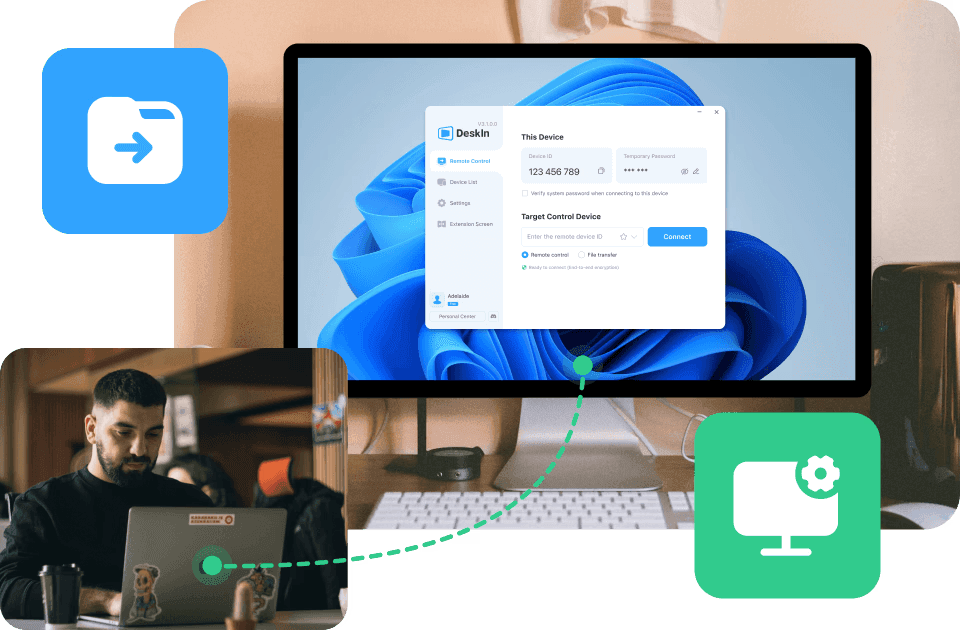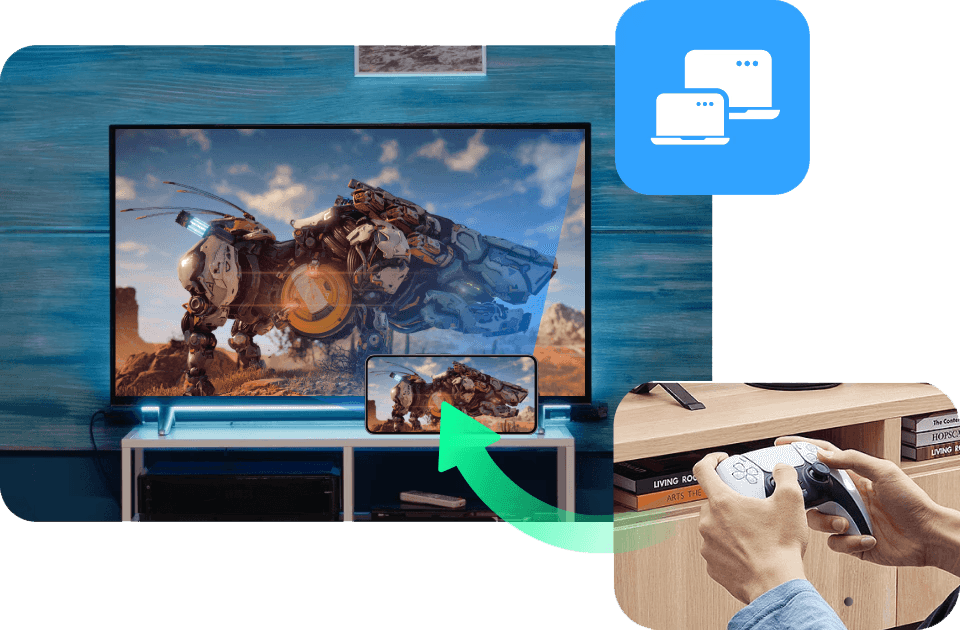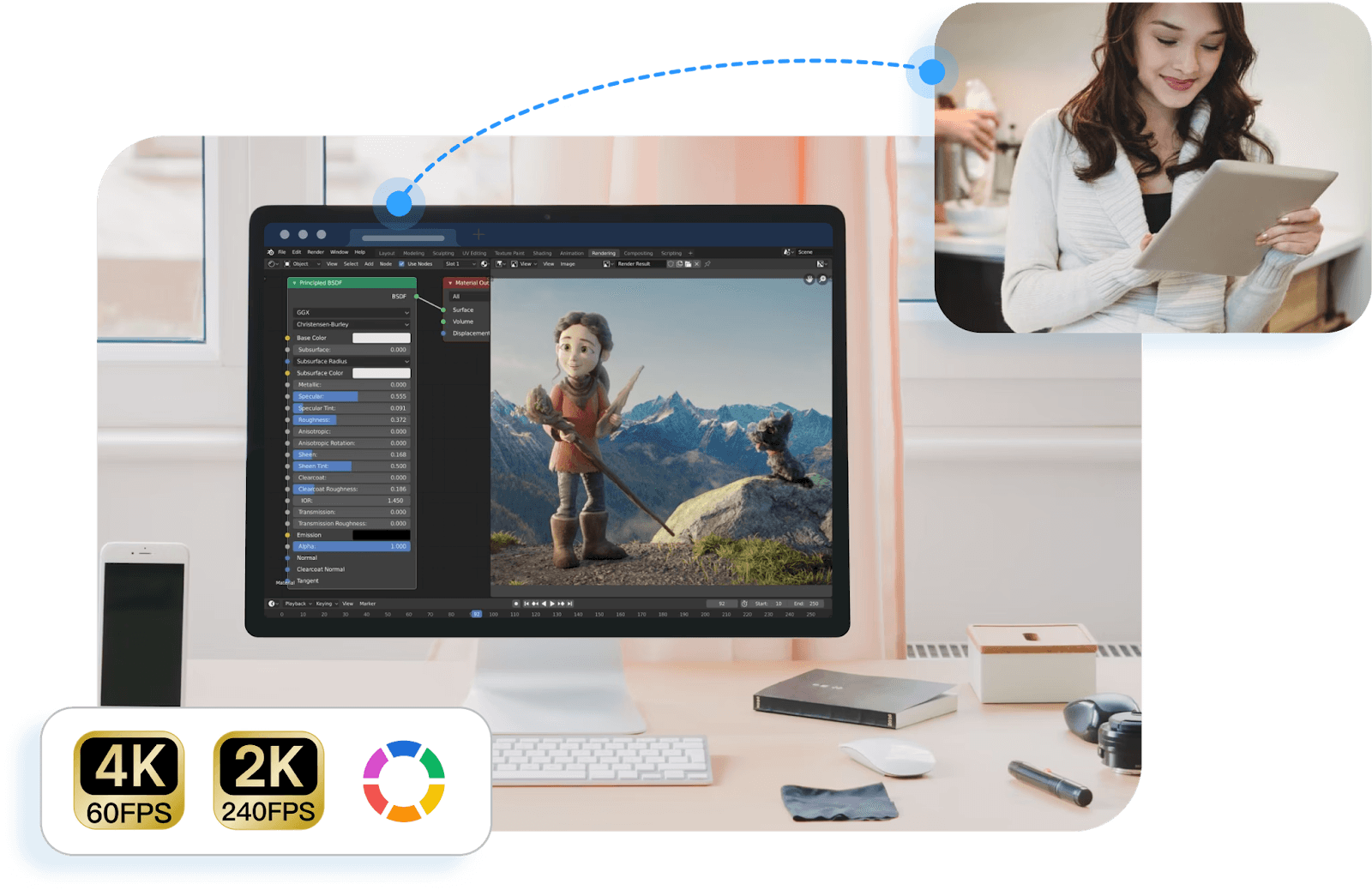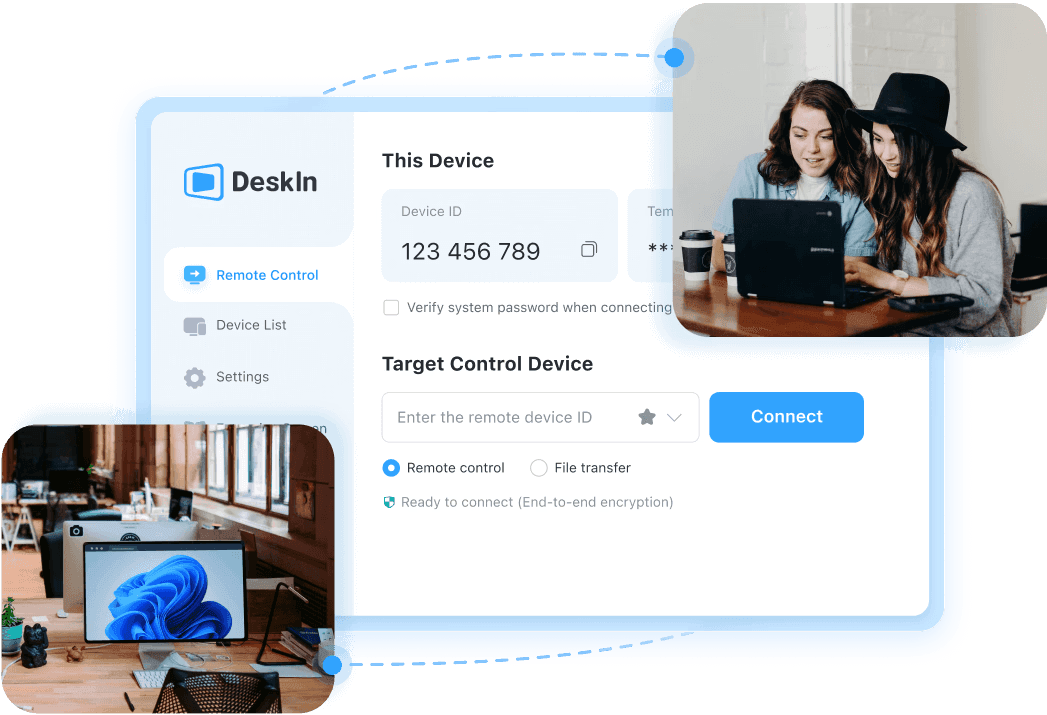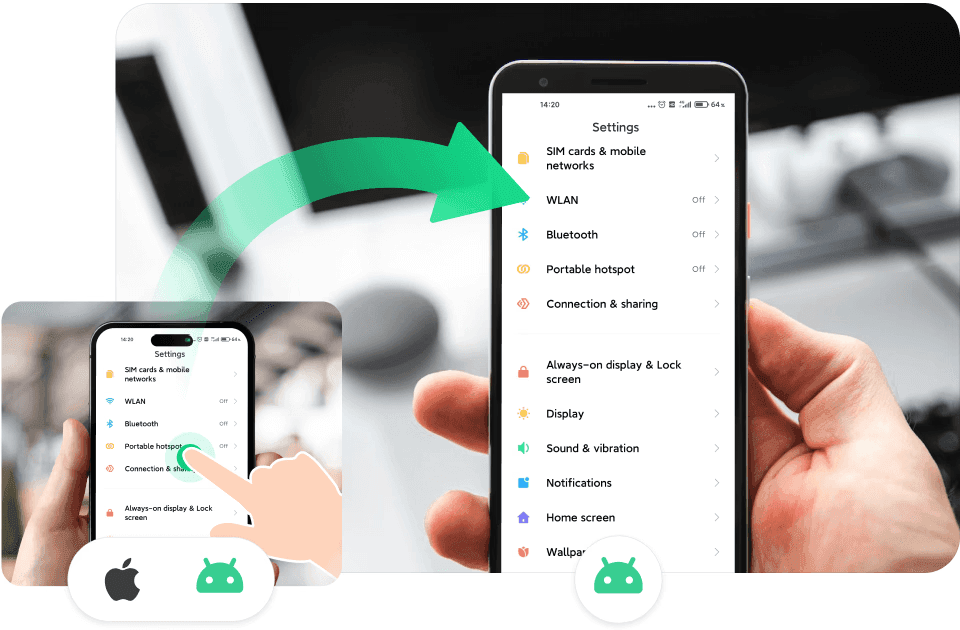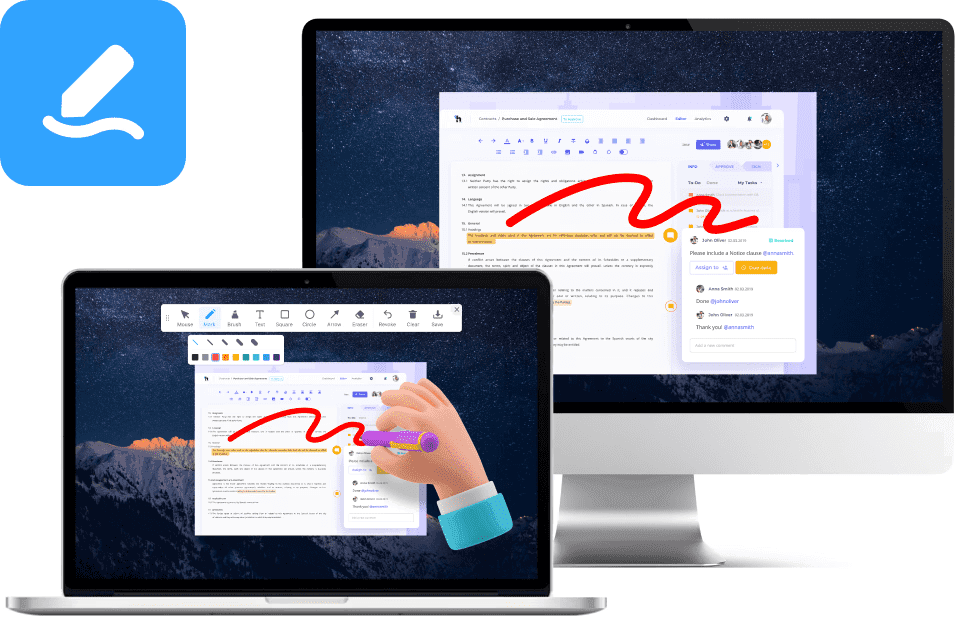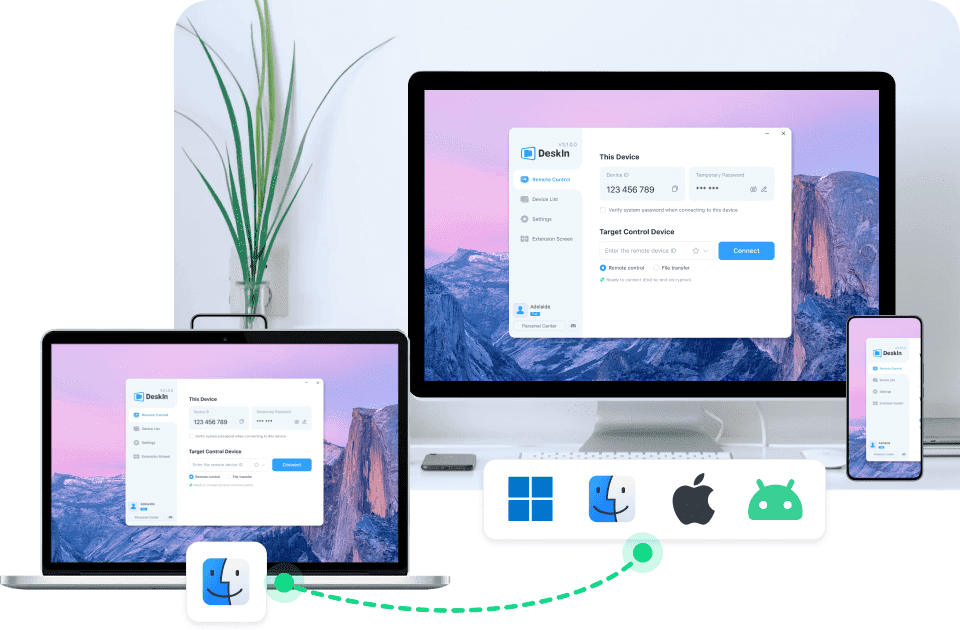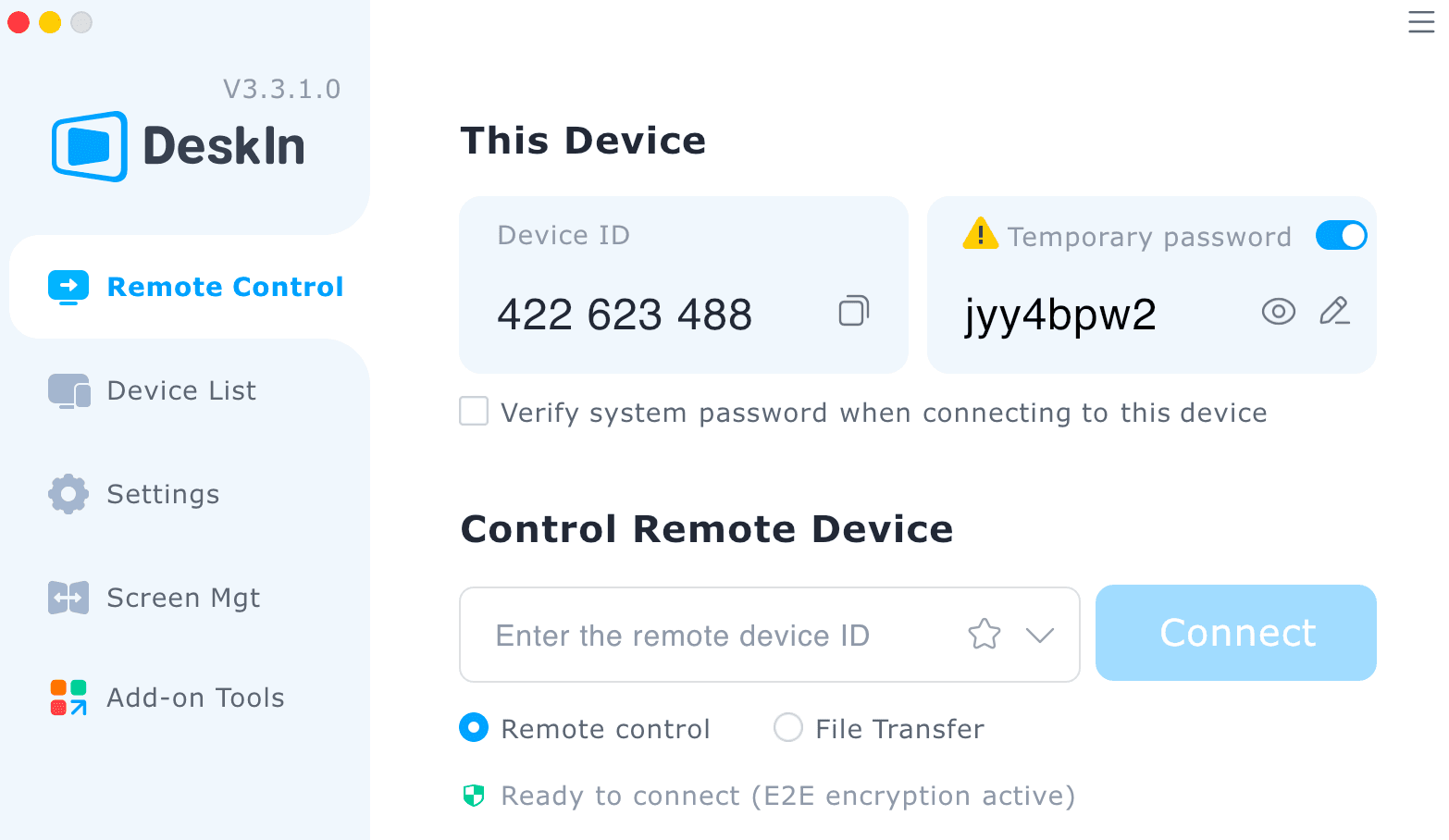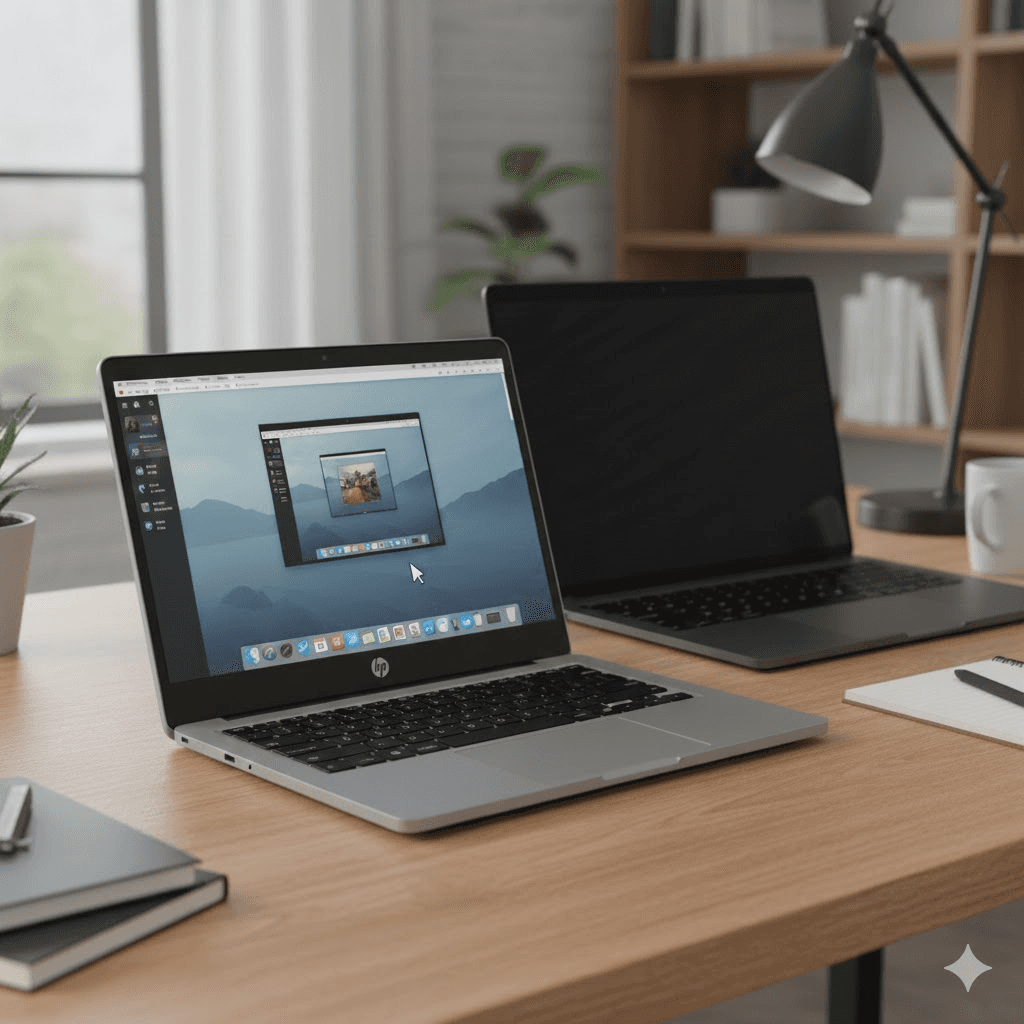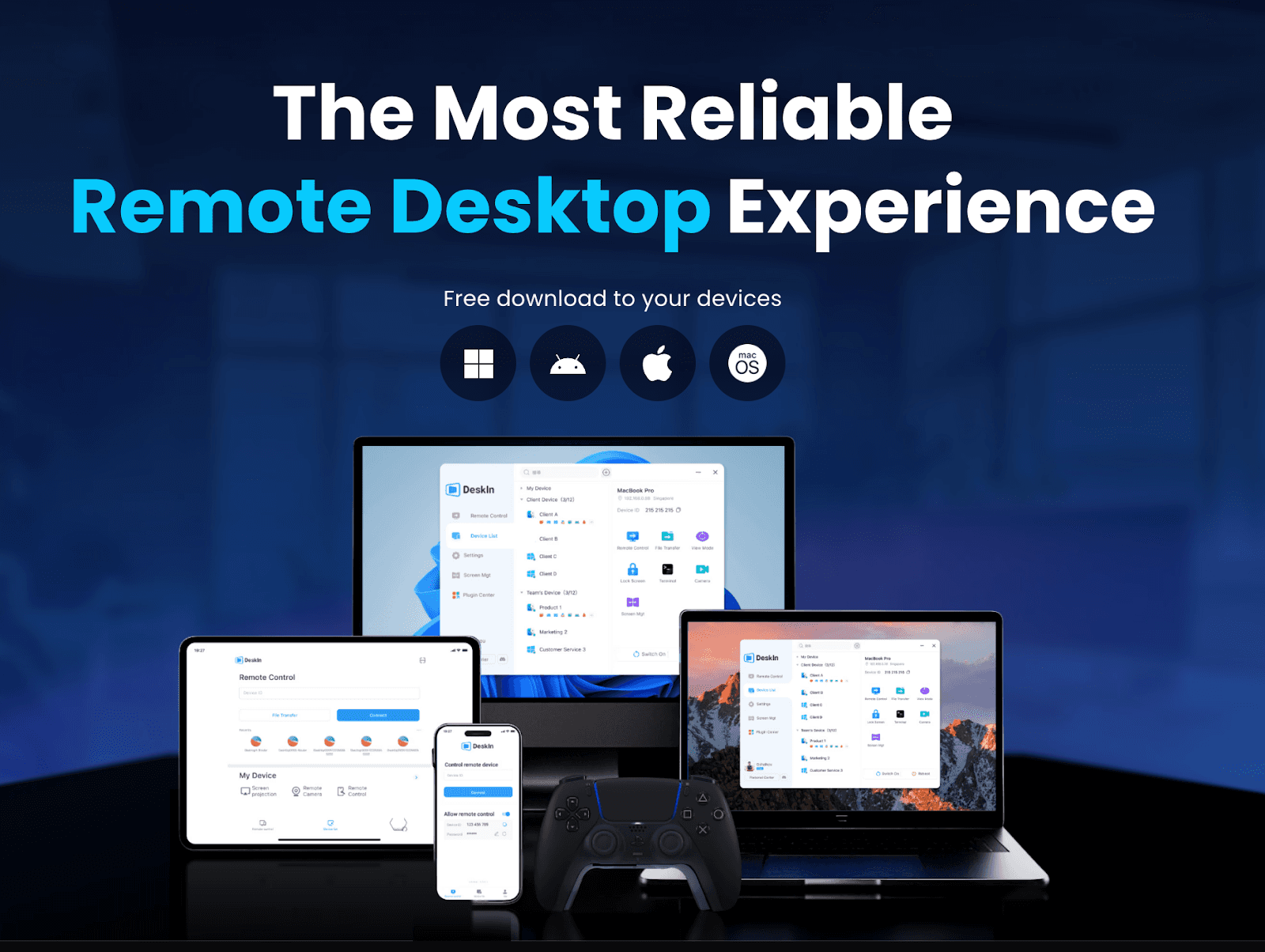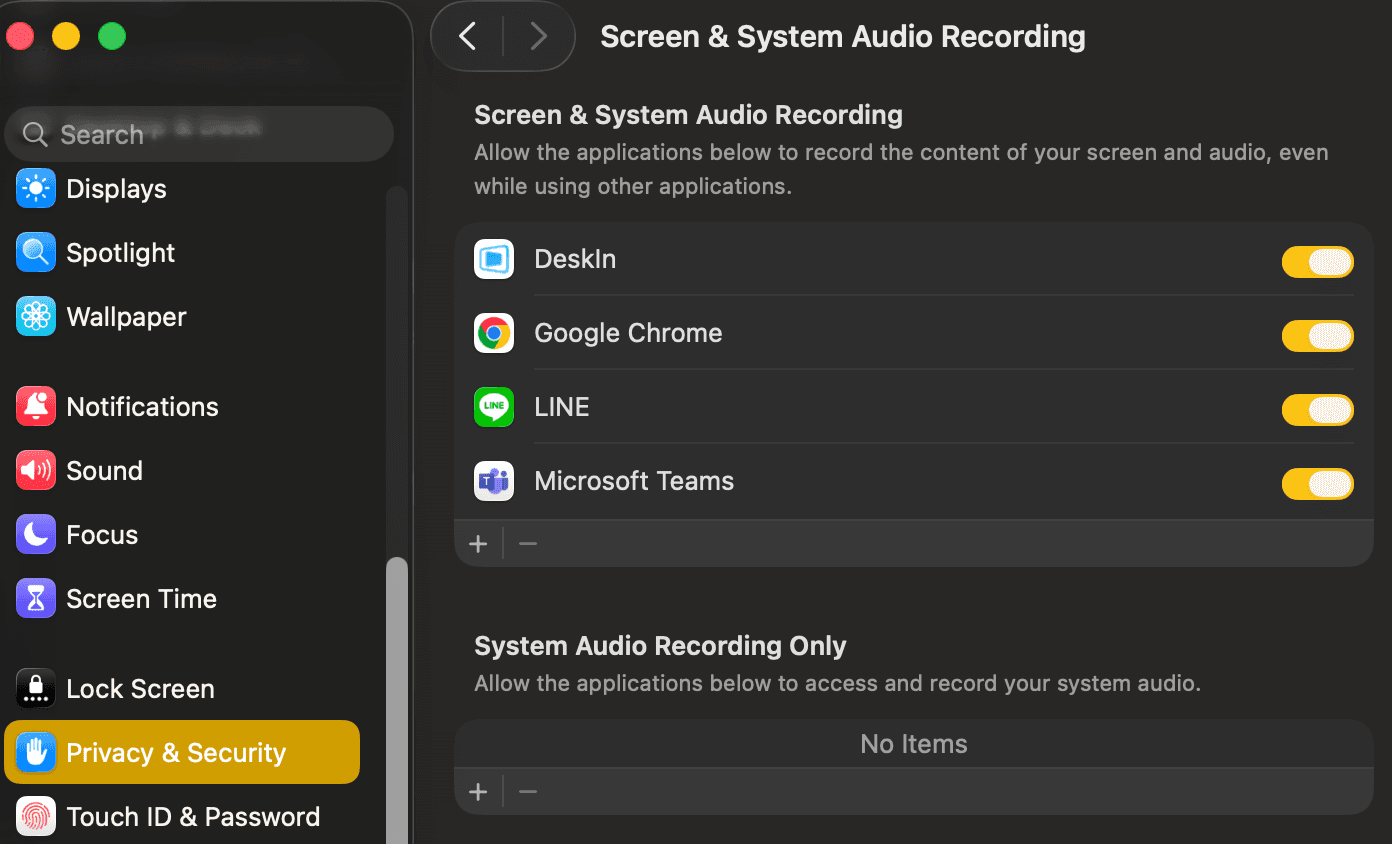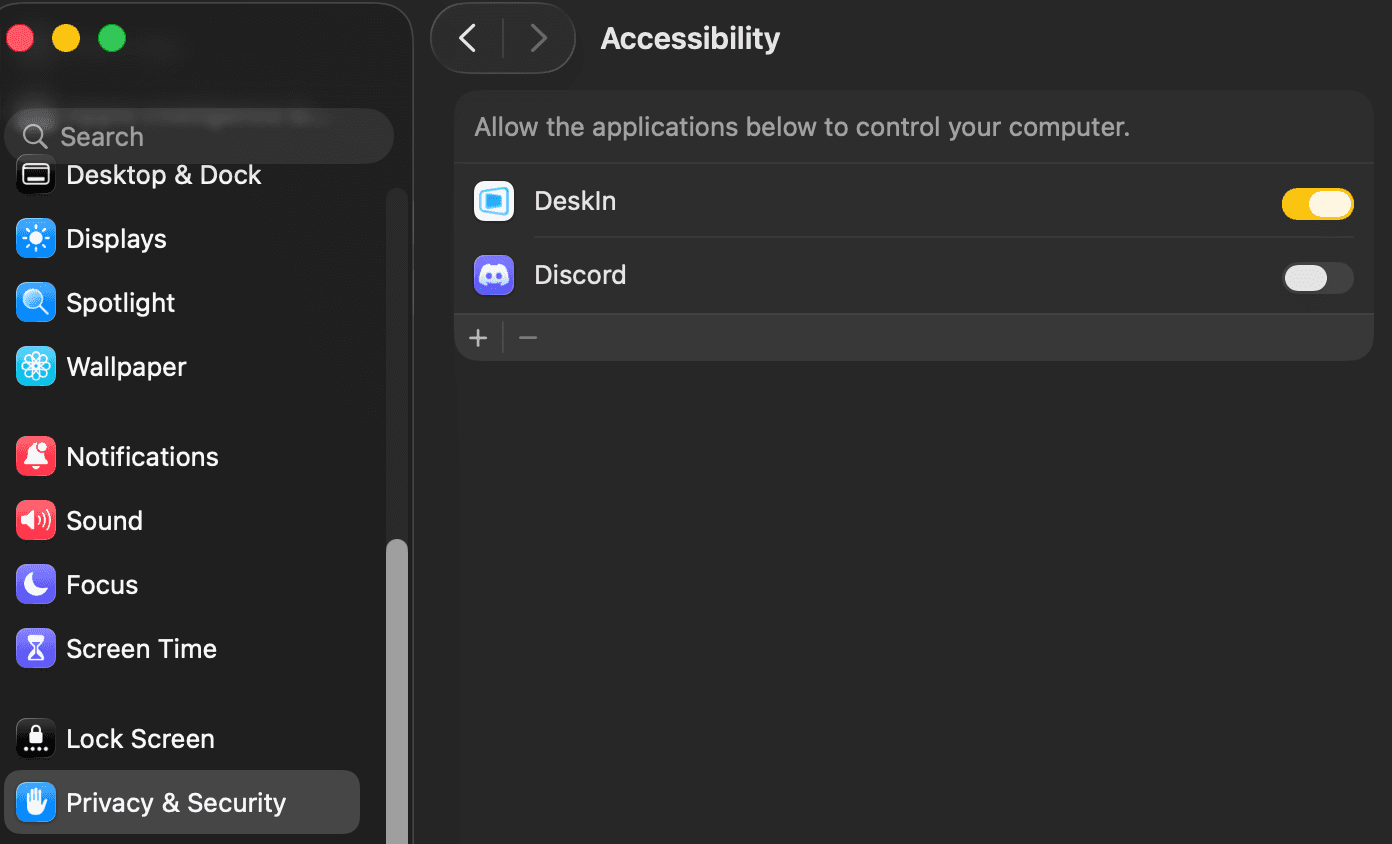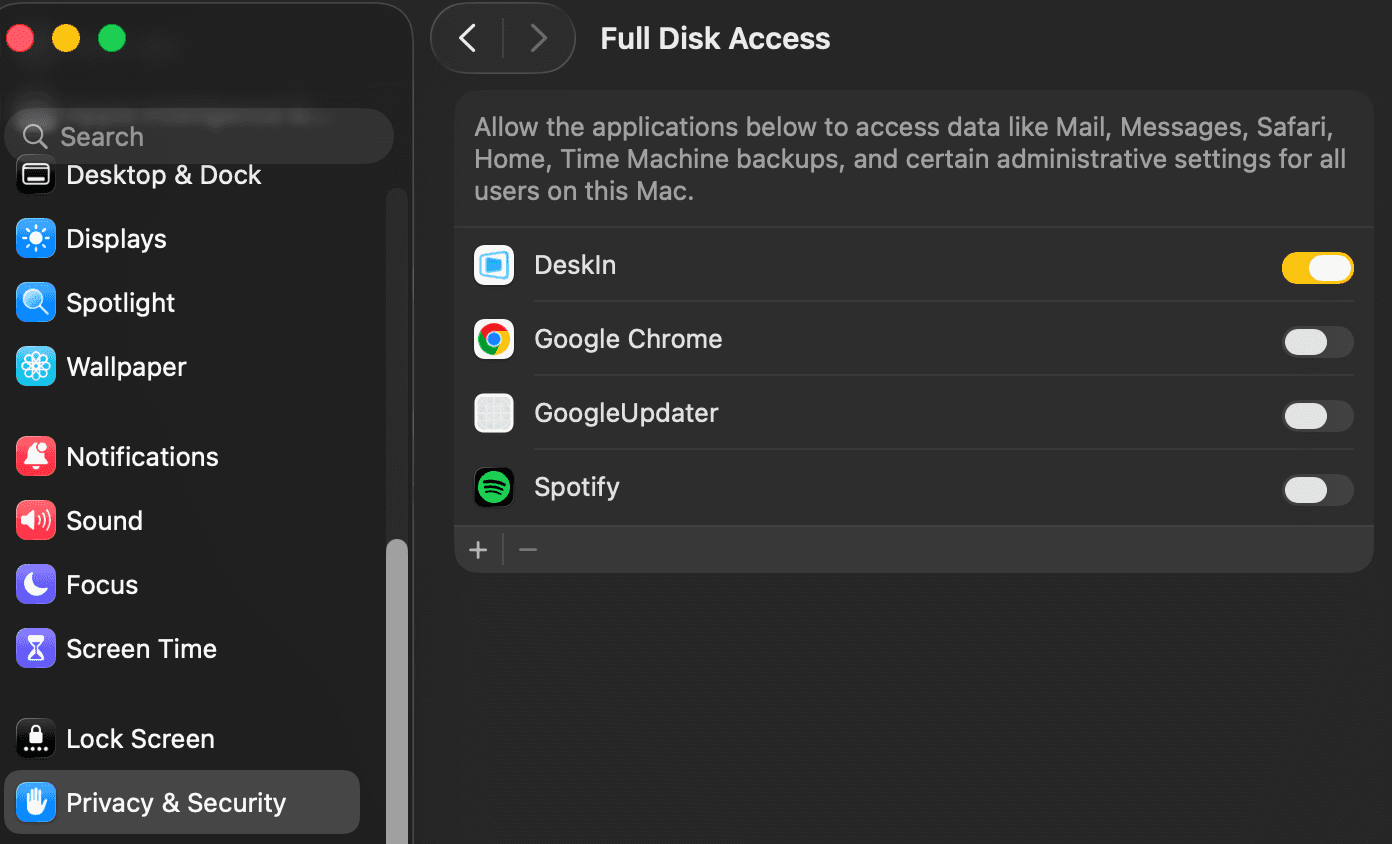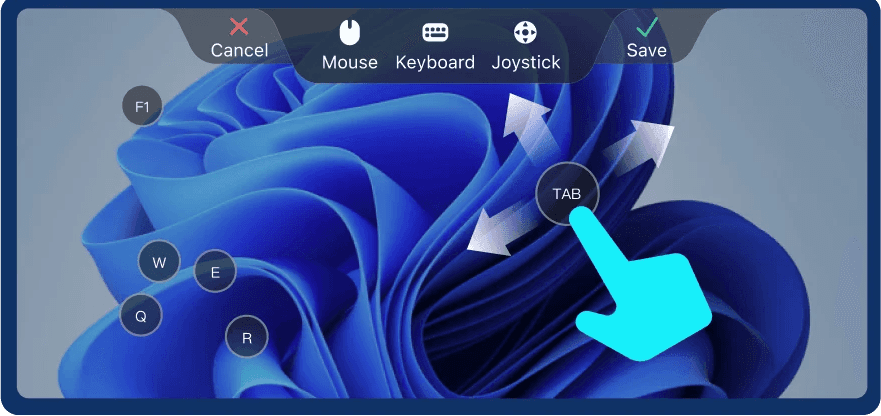在這個以行動裝置為優先的時代,遠端連接兩部 Android 手機可以為便利性、生產力和技術支援開啟全新可能。無論您是想幫朋友解決問題、無需電腦即可傳送檔案,或是進行簡報時鏡像螢幕,Android 手機之間的遠端連接都非常實用。
只要掌握正確工具和操作方式,像是遠距技術支援、協作工作,甚至從一台裝置遊玩另一台裝置上的遊戲等情境,都可以輕鬆實現。接下來,讓我們從最可靠的解決方案開始,探索幾種實測可行的 Android 對 Android 遠端存取方法。
最佳遠端連接兩部 Android 手機的方法:使用 DeskIn
如果您正在尋找最高效且最安全的方法來遠端連接兩部 Android 手機,DeskIn 無疑是首選。無論是一般使用者還是專業人士,DeskIn 的 Android 應用程式都能提供即時控制、檔案分享與螢幕鏡像等功能,操作簡單、體驗流暢。
DeskIn 與眾不同之處在於其高效能、跨平台相容性,以及企業級安全性,全都整合在一個易於使用的介面中。不論您是使用 Samsung 還是其他 Android 裝置,DeskIn 都能提供靈活可靠的 Android 對 Android 遠端存取解決方案。
👍 為什麼選擇 DeskIn 進行遠端連接:
穩定連線:擁有超過 200 個全球節點支援,即使在無線網路訊號較弱時,也能確保低延遲與穩定的效能。
功能豐富:可遠端控制另一部 Android 手機、傳輸速度高達 12MB/s 的檔案、螢幕鏡像、註解、語音通話等功能一應俱全。
跨平台支援:支援 Android、iOS、Windows 與 macOS,可在所有裝置間無縫整合。
強化安全性:具備電子郵件驗證、隱私螢幕、黑白名單控制與無人值守存取設定。
高性價比方案:提供大方的免費版本,且相較其他主流遠端控制工具定價更具競爭力。
現在,讓我們一步步操作,教你如何使用 DeskIn 應用程式在兩部 Android 裝置之間建立遠端連線。
步驟 1:造訪 DeskIn 官方網站,或在 Google Play 上搜尋並下載 DeskIn,然後在兩部 Android 裝置上安裝該應用程式。

步驟 2:使用你的電子郵件地址註冊帳號並完成驗證。在兩部裝置上登入帳戶,以建立安全的存取連線。
📌 注意:首次在新裝置上登入帳號時,須完成電子郵件驗證,以確保帳戶安全性。
步驟 3:登入後,確認你想被控制的那部 Android 手機的「裝置 ID」。
在控制端裝置上輸入該裝置 ID 及對應密碼,並確保目標裝置的 DeskIn 設定中已啟用「允許遠端控制」。

步驟 4:連線建立後,你即可遠端操作另一部 Android 手機。你可以開啟應用程式、傳送訊息、傳輸檔案等等。
👀 你可能也會感興趣:
《為什麼我無法遠端控制我的 Android 裝置?已修復!》
其他讓兩部 Android 裝置互聯的方法
雖然 DeskIn 提供一個功能完整且安全的 Android 對 Android 遠端存取解決方案,但針對像是檔案分享或快速配對等簡單用途,也有一些內建的方法可用。以下是兩種常見的無線連接方式:
使用藍牙進行無線檔案傳輸
藍牙是最古老且最簡單的 Android 手機間無線連接方式之一,適合短距離的檔案傳輸與基本裝置配對。雖然它不支援完整的遠端控制功能,但仍然適用於傳送媒體、聯絡人或小型檔案。
以下是如何透過藍牙讓兩部 Android 裝置遠端連線的步驟:
在兩部 Android 手機上開啟「設定」,並啟用藍牙功能。
在其中一部手機上點選「配對新裝置」,然後從可用裝置清單中選擇另一部手機。
在兩部裝置上確認配對請求。
配對完成後,選取你要傳送的檔案,點選「分享」,並選擇藍牙作為分享方式。
在接收裝置上接受來自對方的檔案傳輸請求。

使用 Wi-Fi Direct 的步驟如下:
在兩部 Android 裝置上開啟「設定 > 連線 > Wi-Fi」。
點選「Wi-Fi Direct」選項(通常可在右上角的三點選單或進階設定中找到)。
裝置將開始掃描,找到另一部裝置後請點選以進行連線。
在第二部裝置上接受連線請求。
開啟支援 Wi-Fi Direct 的應用程式(例如相簿或檔案總管),選取要傳送的檔案,透過 Wi-Fi Direct 進行分享。

📱 遠端連接 Android 裝置的實用情境
除了技術層面的設定之外,了解遠端存取 Android 裝置在現實生活中的應用場景也非常重要。無論是為了個人便利、專業協作,或是協助他人,以下這些情境展示了為什麼學會如何遠端連接兩部 Android 手機越來越有價值。
🔧 遠端協助與故障排除
遠端連接兩部 Android 裝置最常見的用途之一,就是提供技術支援。當親朋好友在操作設定、應用程式或網路問題上遇到困難時,你可以直接控制對方的 Android 裝置進行故障排除,而不必透過電話一步步教學。這對於年長者或不熟悉科技的使用者特別有幫助,讓你可以直接點擊、滑動和操作,加快修復流程,減少誤解與挫折。
👪 家長監控使用情況
家長可以透過遠端方式監控孩子的 Android 裝置,以確保其安全上網、管理螢幕使用時間,或檢查應用程式使用狀況。遠端存取讓家長不必實體拿到孩子的手機,也能掌握裝置狀態,提供更高程度的監督與保護。
📷 遠端存取相機功能
某些遠端控制應用程式(如 DeskIn)支援存取裝置的相機,讓 Android 手機搖身一變成為可攜式監視鏡頭。這在查看寵物動態、家庭安全監控,或是遠端觀察環境時特別實用。
📁 檔案分享與協作
需要傳送大檔案或跨裝置協同工作?兩部 Android 手機間的遠端連線可讓你直接傳輸文件、照片和影片,無需仰賴雲端服務。這對於學生分享課業內容、同事協作處理專案、或是創作者即時交換素材都非常理想,具備高速傳輸能力且無檔案格式限制。
📺 畫面鏡像用於簡報與多媒體分享
透過螢幕鏡像功能,你可以將一部 Android 裝置的畫面顯示在另一部裝置上,這非常適合行動簡報、影片播放或展示應用程式操作方式。即使處於不同網路環境下也能運作,是會議、差旅或娛樂時的實用工具。
📌 Android 對 Android 遠端存取常見問答
問:我可以無線遠端連接兩部 Android 手機嗎?
可以。大多數現代遠端控制工具支援透過 Wi-Fi 或行動數據進行無線連線。這代表兩部裝置不需要在同一區域網路下,也可以進行遠端連線,即使相隔數百公里也沒問題。
問:我可以遠端控制通話設定或接聽來電嗎?
部分進階工具可提供對通話相關功能的部分控制。雖然你可能無法直接遠端接聽一般語音通話,但某些應用程式可以讓你:
檢視並管理來電通知
調整鈴聲或音訊設定
在遠端連線過程中使用語音通話功能,進行即時協助
📌 遠端存取是否安全且保護隱私?
安全性取決於你選擇的應用程式。值得信賴的遠端存取應用會採用強加密技術、安全登入(例如郵件驗證或雙重身份驗證)以及隱私設定(如螢幕遮罩或黑白名單控制)。務必選擇可靠的工具,以確保遠端連線期間你的資料得到妥善保護。
📌 它能在三星手機上運作嗎?
完全可以。大多數遠端存取應用都與三星及其他熱門 Android 品牌相容。有些應用甚至針對三星做了特別優化,以提升效能或實現更深入的系統整合。
結論
遠端連接兩部 Android 手機的能力,帶來了廣泛的可能性——從無縫的技術支援與檔案傳輸,到螢幕分享和行動簡報。無論你是要提供遠端協助給朋友、合作完成專案,還是尋找更智慧的多裝置管理方式,Android 對 Android 的遠端存取都能帶來便利、掌控與彈性。
在眾多可用工具中,DeskIn 以其強大的功能組合、跨平台相容性和安全的遠端連線脫穎而出。具備完整裝置控制、快速檔案傳輸及支援行動數據下的螢幕鏡像功能,DeskIn 讓你無論是工作還是個人使用,都能輕鬆遠端連接兩部 Android 手機!

在這個以行動裝置為優先的時代,遠端連接兩部 Android 手機可以為便利性、生產力和技術支援開啟全新可能。無論您是想幫朋友解決問題、無需電腦即可傳送檔案,或是進行簡報時鏡像螢幕,Android 手機之間的遠端連接都非常實用。
只要掌握正確工具和操作方式,像是遠距技術支援、協作工作,甚至從一台裝置遊玩另一台裝置上的遊戲等情境,都可以輕鬆實現。接下來,讓我們從最可靠的解決方案開始,探索幾種實測可行的 Android 對 Android 遠端存取方法。
最佳遠端連接兩部 Android 手機的方法:使用 DeskIn
如果您正在尋找最高效且最安全的方法來遠端連接兩部 Android 手機,DeskIn 無疑是首選。無論是一般使用者還是專業人士,DeskIn 的 Android 應用程式都能提供即時控制、檔案分享與螢幕鏡像等功能,操作簡單、體驗流暢。
DeskIn 與眾不同之處在於其高效能、跨平台相容性,以及企業級安全性,全都整合在一個易於使用的介面中。不論您是使用 Samsung 還是其他 Android 裝置,DeskIn 都能提供靈活可靠的 Android 對 Android 遠端存取解決方案。
👍 為什麼選擇 DeskIn 進行遠端連接:
穩定連線:擁有超過 200 個全球節點支援,即使在無線網路訊號較弱時,也能確保低延遲與穩定的效能。
功能豐富:可遠端控制另一部 Android 手機、傳輸速度高達 12MB/s 的檔案、螢幕鏡像、註解、語音通話等功能一應俱全。
跨平台支援:支援 Android、iOS、Windows 與 macOS,可在所有裝置間無縫整合。
強化安全性:具備電子郵件驗證、隱私螢幕、黑白名單控制與無人值守存取設定。
高性價比方案:提供大方的免費版本,且相較其他主流遠端控制工具定價更具競爭力。
現在,讓我們一步步操作,教你如何使用 DeskIn 應用程式在兩部 Android 裝置之間建立遠端連線。
步驟 1:造訪 DeskIn 官方網站,或在 Google Play 上搜尋並下載 DeskIn,然後在兩部 Android 裝置上安裝該應用程式。

步驟 2:使用你的電子郵件地址註冊帳號並完成驗證。在兩部裝置上登入帳戶,以建立安全的存取連線。
📌 注意:首次在新裝置上登入帳號時,須完成電子郵件驗證,以確保帳戶安全性。
步驟 3:登入後,確認你想被控制的那部 Android 手機的「裝置 ID」。
在控制端裝置上輸入該裝置 ID 及對應密碼,並確保目標裝置的 DeskIn 設定中已啟用「允許遠端控制」。

步驟 4:連線建立後,你即可遠端操作另一部 Android 手機。你可以開啟應用程式、傳送訊息、傳輸檔案等等。
👀 你可能也會感興趣:
《為什麼我無法遠端控制我的 Android 裝置?已修復!》
其他讓兩部 Android 裝置互聯的方法
雖然 DeskIn 提供一個功能完整且安全的 Android 對 Android 遠端存取解決方案,但針對像是檔案分享或快速配對等簡單用途,也有一些內建的方法可用。以下是兩種常見的無線連接方式:
使用藍牙進行無線檔案傳輸
藍牙是最古老且最簡單的 Android 手機間無線連接方式之一,適合短距離的檔案傳輸與基本裝置配對。雖然它不支援完整的遠端控制功能,但仍然適用於傳送媒體、聯絡人或小型檔案。
以下是如何透過藍牙讓兩部 Android 裝置遠端連線的步驟:
在兩部 Android 手機上開啟「設定」,並啟用藍牙功能。
在其中一部手機上點選「配對新裝置」,然後從可用裝置清單中選擇另一部手機。
在兩部裝置上確認配對請求。
配對完成後,選取你要傳送的檔案,點選「分享」,並選擇藍牙作為分享方式。
在接收裝置上接受來自對方的檔案傳輸請求。

使用 Wi-Fi Direct 的步驟如下:
在兩部 Android 裝置上開啟「設定 > 連線 > Wi-Fi」。
點選「Wi-Fi Direct」選項(通常可在右上角的三點選單或進階設定中找到)。
裝置將開始掃描,找到另一部裝置後請點選以進行連線。
在第二部裝置上接受連線請求。
開啟支援 Wi-Fi Direct 的應用程式(例如相簿或檔案總管),選取要傳送的檔案,透過 Wi-Fi Direct 進行分享。

📱 遠端連接 Android 裝置的實用情境
除了技術層面的設定之外,了解遠端存取 Android 裝置在現實生活中的應用場景也非常重要。無論是為了個人便利、專業協作,或是協助他人,以下這些情境展示了為什麼學會如何遠端連接兩部 Android 手機越來越有價值。
🔧 遠端協助與故障排除
遠端連接兩部 Android 裝置最常見的用途之一,就是提供技術支援。當親朋好友在操作設定、應用程式或網路問題上遇到困難時,你可以直接控制對方的 Android 裝置進行故障排除,而不必透過電話一步步教學。這對於年長者或不熟悉科技的使用者特別有幫助,讓你可以直接點擊、滑動和操作,加快修復流程,減少誤解與挫折。
👪 家長監控使用情況
家長可以透過遠端方式監控孩子的 Android 裝置,以確保其安全上網、管理螢幕使用時間,或檢查應用程式使用狀況。遠端存取讓家長不必實體拿到孩子的手機,也能掌握裝置狀態,提供更高程度的監督與保護。
📷 遠端存取相機功能
某些遠端控制應用程式(如 DeskIn)支援存取裝置的相機,讓 Android 手機搖身一變成為可攜式監視鏡頭。這在查看寵物動態、家庭安全監控,或是遠端觀察環境時特別實用。
📁 檔案分享與協作
需要傳送大檔案或跨裝置協同工作?兩部 Android 手機間的遠端連線可讓你直接傳輸文件、照片和影片,無需仰賴雲端服務。這對於學生分享課業內容、同事協作處理專案、或是創作者即時交換素材都非常理想,具備高速傳輸能力且無檔案格式限制。
📺 畫面鏡像用於簡報與多媒體分享
透過螢幕鏡像功能,你可以將一部 Android 裝置的畫面顯示在另一部裝置上,這非常適合行動簡報、影片播放或展示應用程式操作方式。即使處於不同網路環境下也能運作,是會議、差旅或娛樂時的實用工具。
📌 Android 對 Android 遠端存取常見問答
問:我可以無線遠端連接兩部 Android 手機嗎?
可以。大多數現代遠端控制工具支援透過 Wi-Fi 或行動數據進行無線連線。這代表兩部裝置不需要在同一區域網路下,也可以進行遠端連線,即使相隔數百公里也沒問題。
問:我可以遠端控制通話設定或接聽來電嗎?
部分進階工具可提供對通話相關功能的部分控制。雖然你可能無法直接遠端接聽一般語音通話,但某些應用程式可以讓你:
檢視並管理來電通知
調整鈴聲或音訊設定
在遠端連線過程中使用語音通話功能,進行即時協助
📌 遠端存取是否安全且保護隱私?
安全性取決於你選擇的應用程式。值得信賴的遠端存取應用會採用強加密技術、安全登入(例如郵件驗證或雙重身份驗證)以及隱私設定(如螢幕遮罩或黑白名單控制)。務必選擇可靠的工具,以確保遠端連線期間你的資料得到妥善保護。
📌 它能在三星手機上運作嗎?
完全可以。大多數遠端存取應用都與三星及其他熱門 Android 品牌相容。有些應用甚至針對三星做了特別優化,以提升效能或實現更深入的系統整合。
結論
遠端連接兩部 Android 手機的能力,帶來了廣泛的可能性——從無縫的技術支援與檔案傳輸,到螢幕分享和行動簡報。無論你是要提供遠端協助給朋友、合作完成專案,還是尋找更智慧的多裝置管理方式,Android 對 Android 的遠端存取都能帶來便利、掌控與彈性。
在眾多可用工具中,DeskIn 以其強大的功能組合、跨平台相容性和安全的遠端連線脫穎而出。具備完整裝置控制、快速檔案傳輸及支援行動數據下的螢幕鏡像功能,DeskIn 讓你無論是工作還是個人使用,都能輕鬆遠端連接兩部 Android 手機!


Play x Work
All at Once
DeskIn Remote Game
only $14.32 USD 🎉 Limited on July 16-31
Add promo code: deskinsummer1





